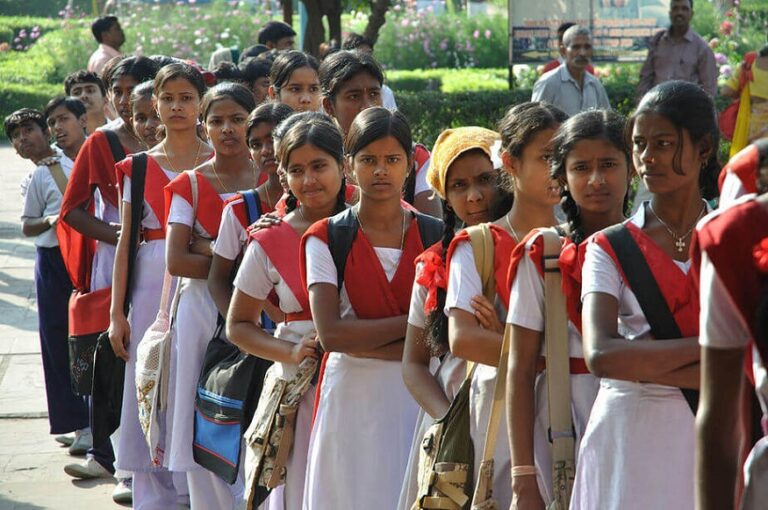The education of girls possesses dual significance as a fundamental human right and an essential force that empowers communities to sustain long-term development. The educational success of girls produces advantages that extend past their achievements.
The education of girls leads to betterment across entire families as well as neighbourhoods and economic systems. A girl who receives a proper education becomes a woman who enhances society by making better parenting decisions and making informed choices to shape her surroundings.
The effects of female education become especially important in Indian communities because they exist as tightly connected networks. This initiative affects the state of health, economic stability, governance, and social growth. Educating girls creates resilient communities while simultaneously building thriving communities through an inclusion-based investment.
The Foundation of Stronger Communities
The acquisition of education allows people to develop confidence, knowledge, and critical thinking abilities, which are fundamental for success in society. Educating girls with high-quality standards enables them to develop capabilities that help them sustain themselves and their communities.
Educated girls possess better employment opportunities, which leads to increased household income and enhanced financial capabilities. Their improved living conditions inspire family members to pursue similar opportunities, which also boosts the quality of life for surrounding individuals.
A community benefits significantly when multiple women receive education. Women who have received education serve as inspirational figures who develop innovative solutions while introducing fresh viewpoints that strengthen community ties and improve local leadership.
Women with education actively participate in social initiatives, health programmes, and parent-teacher organisations. These individuals actively spread information about hygiene, nutrition, and environmental sustainability, which leads to balanced community development.
Education as a Driver of Economic Growth
Numerous studies demonstrate the proven connection between female education and economic development. Economies experience increased growth whenever women join the workforce at higher numbers. Educated women earn higher salaries and accumulate greater savings, which they use for their children’s education, thus creating a positive socioeconomic development pattern for the entire community.
Female education at high levels leads to better household income, reduced criminal activity, and enhanced resource accessibility within communities. The school attendance of girls leads to postponing marriage and childbirth, which decreases public health system strain and creates opportunities for long-term employment.
Educated women serve as the driving force behind productivity levels, which extend from individual businesses up to industrial production. Educated women contribute leadership skills, along with discipline and innovative thinking, to organisational settings. Supporting girls to attain education serves as a vital approach to developing robust and sustainable local economies.
Promote Gender Equality through Education
The primary consequence of educating girls is to promote gender equality. Through their studies, girls work to break traditional gender stereotypes, which leads society toward fairer and more balanced environments.
The education of girls in supportive communities leads to cultural transformations within their communities. Society adopts flexible gender role concepts, together with equal participation standards. The coexistence of educated girls with boys during childhood development leads boys to value women equally, while women build their self-assurance regarding their abilities.
The education of girls proves essential in rural regions and conservative areas of India because these areas have maintained strict gender norms throughout history. Girls who gain education create empowerment for themselves while demonstrating to others through their actions.
The Role of Corporate Social Responsibility
Corporate social responsibility in India has gained significant importance throughout the past few years. Today’s corporate world has realised that supporting girls’ education brings essential value to their societal development commitments. The structured CSR activities of corporations support the development of school facilities while providing training for teachers and funding scholarships and digital tools for girls in marginalised areas.
The types of corporate social responsibility are classified under environmental sustainability, ethical labour practices, and social equity. Education receives special attention in this model because its long-term effects are significant. Businesses support girls in schools by improving their sanitation facilities, distributing free uniforms, and providing sponsored mentoring programmes that guide young females toward their career paths.
Businesses that dedicate their activities to national goals fulfil legal requirements and earn public confidence while establishing themselves as responsible brands. The mutual advantages between organisations and communities drive greater participation in educational changes that expand their collective influence.
Making CSR More Effective
Diverse types of CSR initiatives are adopted for a sustained education impact through active collaboration between parents, teachers, students, and community leaders. Businesses need to determine genuine community requirements, and then join forces with educational institutions and nonprofit organisations.
The short-term benefits of donating once will fade away, while structured programmes such as mentorship, skills training, and health education will deliver lasting, meaningful outcomes. Every CSR plan requires monitoring and evaluation systems to track achievements and develop improvements.
Various businesses now link their operations to government programmes such as Beti Bachao, Beti Padhao, and Skill India to reach more communities. The joint efforts between organisations have demonstrated powerful success in value co-creation.
Girls as Catalysts of Change
Empowering girls creates transformative agents who work beyond individual transformation. Supporting girls’ education in India enables them to become vocal defenders of justice while progressively assuming leadership positions and providing compassionate, intelligent service to their communities. These young women advance into various careers such as teaching, medical practice, business leadership, engineering expertise, and social activism to drive forward the progressive movement.
Any community benefits from having educated women because they help improve governance standards, lower inequality levels, and foster civic responsibility. Through education, their voices gain strength because education serves to strengthen their voices.
Conclusion: Building the Future Starts Today
A brighter and more prosperous India emerges through the education of every girl in the country. We need to maintain efforts for universal school access, together with the safeguarding of safe learning conditions and equal opportunities for everyone.
The realisation of girls’ education throughout every region of the country requires united efforts from corporate sponsors, community organisations, and government policy support. The convergence of compassion with planning and continuous action will transform our communities into better versions of themselves.
Societies need to understand that girls’ education creates fundamental pillars that elevate entire communities to greatness. The delivery of quality education leads to developing stronger futures, which benefit each girl and her corresponding community.



















+ There are no comments
Add yours